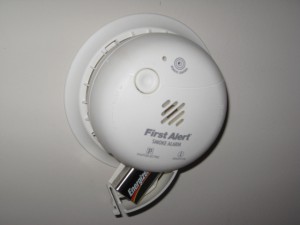
Test the smoke alarm once a week by pressing the Test-Reset button
Staying safe is the #1 priority while at home, whether we think about it or not. But there are certain things we should be doing to keep our emergency action plans up-to-date, yet we don’t do them nearly enough.
October 5th through 11th is Fire Prevention Week, and according to the National Fire Protection Association (NFPA), Americans don’t test their smoke alarms nearly enough. It is recommended that we test our smoke detectors once a month, just to make sure they’re working properly. Their reaction to smoke in the house might be the difference that saves a life.
So take 5 minutes out of your day – today – to test your smoke detector. Follow these 3 steps and you’ll have peace of mind for a month.
- Make sure you have smoke detectors
In order to do a test, you actually need a smoke detector installed. If you don’t have one, the great news is that they are relatively inexpensive, many ranging from $10-$20.
- The smoke detectors must be properly positioned
If you’ve installed a smoke detector in the wrong spot, it could prevent the alarm from working correctly. Insulation, distance from certain rooms and wall blockage all play a part in disrupting the alarms from their job. The positions vary depending on age of home and location, so check this helpful guide for more information.
- Perform the test
Let everyone in your house know that you are going to test the alarms and ask one member of your household to move to the furthest room from the alarm. This will tell you whether the beep is loud enough to reach all rooms. Push and hold the test button (usually colored red) for a few seconds. You can also check to see if the alarm would work in an actual fire by purchasing an aerosol smoke detector test can. Spray onto the detector, wait a few seconds and (if working properly), you’ll hear the alarm.
You’ll need a vacuum nearby when using the spray. To silence the alarm, use the vacuum nozzle to suck in all the test material.
That’s it! Be sure to place a reminder on the fridge, your calendar or your phone alarm each month to perform the test. After you perform steps 1 and 2 the first time, you won’t have to do them again as long as you reside in that house.
